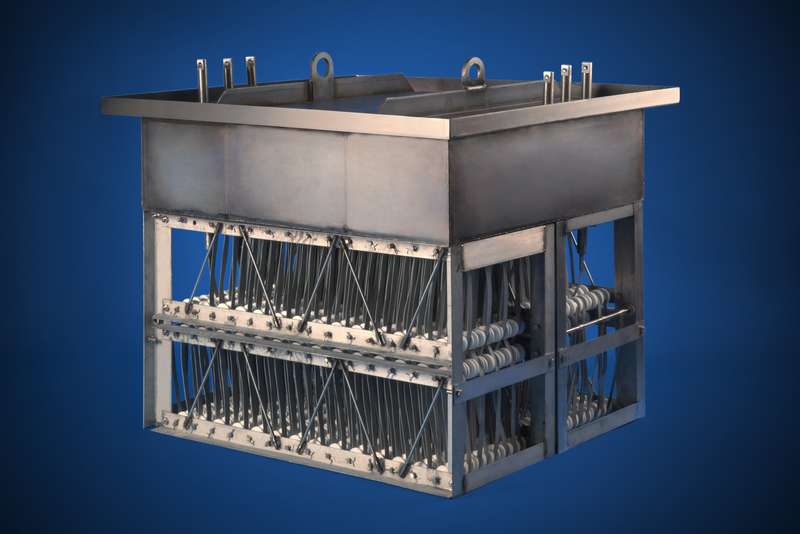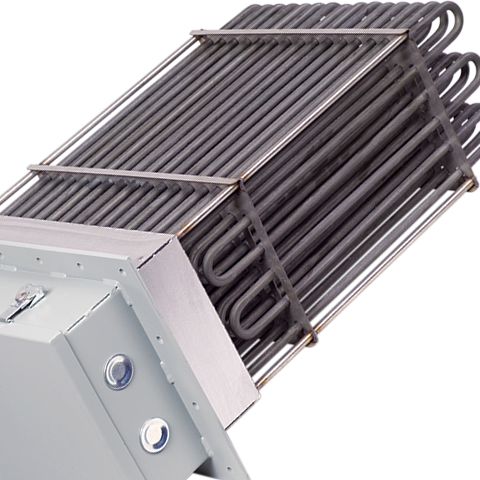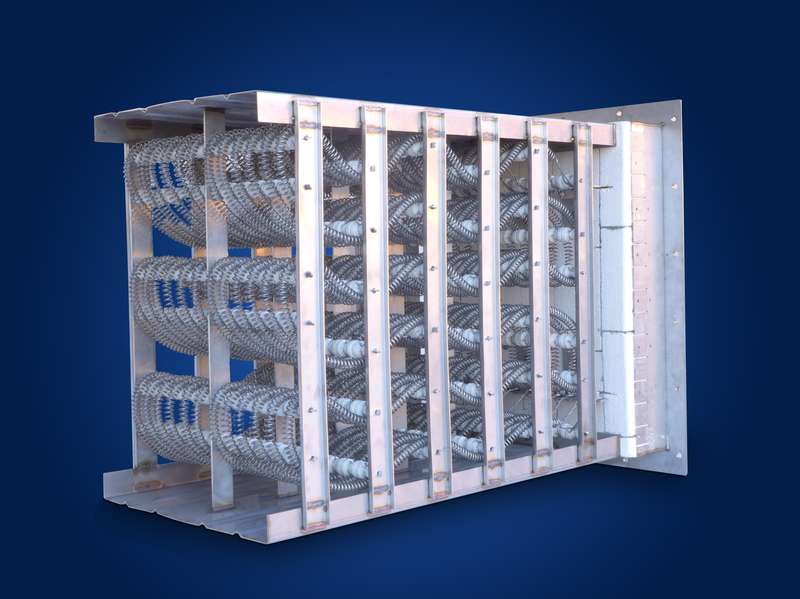Tubular, open coil or ribbon Process duct heaters: What is the best option?

Did you know that Volton has been manufacturing and refurbishing process duct heaters for high temperature industrial applications for several decades?
These duct heaters are used for the heat treatment of metals or for high temperature convection heating, usually in large furnaces.
These Process duct heaters are manufactured either with:
- Nickel-Chrome 80/20 heating ribbons
- Nickel-chrome 80/20 or Kanthal A-1 open coils
- Tubular elements in incoloy
As for the heating ribbon or open coil, these are very large calibers formed and supported by cylindrical ceramic insulators and a very robust stainless steel structure.
Volton manufactures and refurbishes heating ribbons and open coils process duct heaters. For tubular process duct heaters, we can refurbish them but we do not manufacture them.
A case that triggers a debate!
Recently, we responded to a call for tenders from a customer in Quebec who wanted to renew its fleet of Process duct heaters.
By responding to the call for tenders, we tried to enlighten him on the “pros and cons” of a ribbon, open coil or tubular duct heater, in order to help him choose while having full knowledge of the facts.
Here is a summary of the points discussed. Always keep in mind that the option for you depends a lot on the conditions in which your own ovens operate.
Heating ribbon Process Duct heaters
In the case of this tender, the ribbon duct heater was a risky choice as the customer’s environment was very dusty, the airflow not optimal, allowing the ribbon duct heater to get clogged by dust. The ribbon heating element tends to lengthen by heating (phenomenon of thermal elongation). However, the ribbon can reach 1260oC. So we have several clients who use ribbon duct heaters without durability problems. It’s all a question of design and again, the client’s environment.

Heating ribbon process duct heater manufactured at Volton. We also refurbish them.
Tubulars Process Duct heaters
The tubular elements eliminate the risk of short circuit, the tube being isolated from the internal heating element.
Open coil elements can also be a solution since they can easily be attached to the ceramics supporting it, constraining its motions. Thermal elongation is then allowed by the shape of the elements’ spring, regulating the problem that we may encounter with the ribbons.

Tubular elements duct heater
Small… or big downside!
The heating elements of the duct heater must withstand the worst condition of use, i.e. a reduced air velocity (clogged air circulation forming a hot spot) at the final operating temperature of 620oC in the specific case studied here.
However, never forget that your operating temperature is not the temperature the elements reach on their surface. Since they heat up, it is much higher.
Tubular elements have a limited surface temperature depending on the material of the tube sheath, the most common being Incoloy at 815oC, the highest being the Inconel tube at 870oC. The maximum permissible power density on the elements would then be of the order of 19 kW/m2 (12 W/in2) for the Incoloy and 28 kW/m2 (18 W/in2) for the Inconel. Tubulars with Inconel tubes are much more expensive, for a result that will once again be limited by the temperature the tube can withstand.
The power density of the tubulars must therefore remain low, given the temperature limit of the sheath. A moderately dusty environment, however, causes low-density elements to overheat to perform, causing the temperature on the surface of the elements sheath to increase. It is therefore a vicious circle since the solution would lie in adding more tubulars in the duct heater (increased costs) but by doing this, given the path of air flow, more tubulars would have the effect of obstructing the passage of air through the duct heater, thus allowing dust to accumulate even more on the sheath, and the degrees to increase on its surface.
| Over the years, we have seen several companies using Tubular process duct heaters for high temperature applications |
| approaching us, stating that their duct heaters did not have the expected longevity. Now you understand why! |
| Be careful, however, not to get confused with a heating application that is not high temperature, for which, |
| tubular elements are a winning choice. |
Open coil Process Duct heaters
As for the elements of spiral-wound resistive wires (coils), they have a surface temperature limited by the resistive material used. For high temperature uses, the most common alloy is KA1 (FeCrAl) and its maximum temperature depends on the caliber used. In the case at hand, we selected a wire alloy that could reach around 1285oC. Depending on the alloy, a spiral-wound heating wire can reach up to 1350oC. The maximum permissible power density on the element in this case was then of the order of 144W/m2 (90 W/in2). A more reasonable power density would be in the range of 31 to 46 kW/m2 (20 to 30 W/in2) for element temperatures below 950oC ensuring increased coil longevity and substantial long-term savings.

Open coil duct heater manufactured at Volton. We also refurbish them.
If, despite everything, you choose tubular duct heaters for high-temperature application, monitor the lifespan of your duct heaters. Reconditioning a tubular duct heater is often more expensive than reconditioning a ribbon or open coil duct heater.
In short, contact us and we will provide you with the best option considering your own reality!
 Skip site navigation
Skip site navigation




















